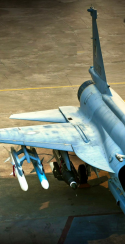You are using an out of date browser. It may not display this or other websites correctly.
You should upgrade or use an alternative browser.
You should upgrade or use an alternative browser.
JF-17/FC-1 Fighter Aircraft thread
- Thread starter johnqh
- Start date
A lot of delegations but not many new contracts i am afraid. I think the "prime opportunity window" for the JF17 has gone now, since it took soo long to get the variant most people were interested in, ie Block III. There are better options now, and the world is increasingly moving onto 5th stealth platforms.
kwaigonegin
Colonel
I agree. I think future warfare will either be assymetrical warfare with less sophisticated enemies or with a near peer. Both ends of the spectrum. Fighting terrorists or insurrectionists doesn't require the latest or even previous Gen fighters.A lot of delegations but not many new contracts i am afraid. I think the "prime opportunity window" for the JF17 has gone now, since it took soo long to get the variant most people were interested in, ie Block III. There are better options now, and the world is increasingly moving onto 5th stealth platforms.
A1980s A10, F16 etc. can do the same amount of damage as a 2020s JF17, J10 etc. if you're trying to bomb a mud hut or fighting a group of folks with AKs and RPGs. All you need is adequate amount of chaff and a good ECM pod to guard against SFSAMs.
OTOH Both types would be sorely inadequate to deal with 5th Gen fighters.
A country like Pakistan needs the latest against India however they can also go low tech against terrorists. 'Medium Tech' is getting less and less practical it seems due to shifting of global geopolitics and also traditionally 'poor 3rd world countries modernizing and becoming much richer in the decades to come.
I agree. I think future warfare will either be assymetrical warfare with less sophisticated enemies or with a near peer. Both ends of the spectrum. Fighting terrorists or insurrectionists doesn't require the latest or even previous Gen fighters.
A1980s A10, F16 etc. can do the same amount of damage as a 2020s JF17, J10 etc. if you're trying to bomb a mud hut or fighting a group of folks with AKs and RPGs. All you need is adequate amount of chaff and a good ECM pod to guard against SFSAMs.
OTOH Both types would be sorely inadequate to deal with 5th Gen fighters.
A country like Pakistan needs the latest against India however they can also go low tech against terrorists. 'Medium Tech' is getting less and less practical it seems due to shifting of global geopolitics and also traditionally 'poor 3rd world countries modernizing and becoming much richer in the decades to come.
Most countries cannot afford 5th Gen fighters. Less developed countries used to be able to afford F-16A and MiG-21, they would not be able to afford F-35. If they are on good terms with Western countries, then used aircraft are a possibility (i.e. Croatia), if not, then where else can you go besides JF-17?
A lot of delegations but not many new contracts i am afraid. I think the "prime opportunity window" for the JF17 has gone now, since it took soo long to get the variant most people were interested in, ie Block III. There are better options now, and the world is increasingly moving onto 5th stealth platforms.
As for opportunities being gone now, that is a premature statement considering that a few contracts, like those with Azerbaijan (BLK III), Qatar (BLK II - B variant), and additional units (sqd) for Nigeria, are very much in the final stages. In addition, these visits are not fam trips; rather, the visiting nations have noticed something in BKL-III that appeals to them.
Furthermore, geopolitics also had a significant impact on the refusal of several nations, like Argentina, Malaysia, Iraq etc.
As for opportunities being gone now, that is a premature statement considering that a few contracts, like those with Azerbaijan (BLK III), Qatar (BLK II - B variant), and additional units (sqd) for Nigeria, are very much in the final stages. In addition, these visits are not fam trips; rather, the visiting nations have noticed something in BKL-III that appeals to them.
Furthermore, geopolitics also had a significant impact on the refusal of several nations, like Argentina, Malaysia, Iraq etc.
Come on,,, Azerbaijan is on the list since years and still nothing … Qatar wont buy JF-17s given that they can chose whatever they want … yes, Nigeria may be an option, but even such „already signed“ reports like Iraq are far from confirmed.
Come on,,, Azerbaijan is on the list since years and still nothing …
So......
It makes sense that such acquisitions would take time given Azerbaijan's low defense budget.
Qatar wont buy JF-17s given that they can chose whatever they want …
And what leads you to believe that despite possessing a large budget, they won't purchase "Medium Tech" fighters? As previously noted, Qatar is interested in JF-17B (BLK II), maybe as LIFT.
but even such „already signed“ reports like Iraq are far from confirmed.
Read my post below once more.....
Furthermore, geopolitics also had a significant impact on the refusal of several nations, like Argentina, Malaysia, Iraq etc.
As for opportunities being gone now, that is a premature statement [...]
Apologies if it comes too close to OT but this comment sparked my interest in the potential market for JF-17. I never thought about this so I gave it a shot and here's what came out:
I think what distorts the picture is the fact that we don't think how platform influences upgradeability and how marketing and PR influence perception.
- J-7 can't fit better sensors because of its size but if it did we would see it in action more often and instead we only see upgradeable platforms
- A-37 is used regularly throughout South America but we don't see it because they are not part of PR intended for current products
The aerospace industry is in a peculiar place right now as there are no cheap "proper multirole" aircraft already in production or entering production apart from:
- CAC/PAC JF-17C Block III
- HAL Tejas Mk1A
- KAI FA50 Block2/PL
Western aircraft are too expensive. T-7 won't make it to the market. Turkey plans to replace F-16s with 5gen. Lack of outsourced F-16 production will maintain cost barrier. MiG-35 is not cheap enough. Russia faces: sanctions, shortage of funds, industry busy with war, loss of status affecting preference abroad. This opens up the market that would be problematic otherwise.
From IISS The Military Balance: nominally active (additional stored)
| country | Su-30 | Su-27 | MiG-29 | MiG-23 | MiG-21 | MiG-23BN | Su-22 | Su-25 | F-16 | F-5 | Mirage | A-37 | J-7/F-7 | JF-17 |
| Angola | 12 | 6 | 18 | 20 | 8 | 13 | 8 | |||||||
| Ethiopia | 11 | 8 | 3 | |||||||||||
| Sudan | 22 | 14 | ||||||||||||
| Kenya | 21 | |||||||||||||
| Uganda | 6 | |||||||||||||
| Tanzania | 11 | |||||||||||||
| Mozambique | 8 | |||||||||||||
| Namibia | 6 | |||||||||||||
| Zambia | 11 | |||||||||||||
| DR Congo | 4 | |||||||||||||
| Nigeria | 12 | 3 | ||||||||||||
| Tunisia | 11 | |||||||||||||
| Syria | 30 | 25 | 50 | 20 | 20 | |||||||||
| Venezuela | 20 | 19 | ||||||||||||
| Cuba | 5 | 16 | ||||||||||||
| Peru | 19 | 4 (14) | 12 | 15 | ||||||||||
| Honduras | 11 | 6 | ||||||||||||
| Salvador | 14 | |||||||||||||
| Uruguay | 12 | |||||||||||||
| Sri Lanka | 5 | |||||||||||||
| Myanmar | 32 | 21 | 16 | |||||||||||
| Bangladesh | 8 | 47 | ||||||||||||
| Turkmenistan | 24 | 31 | ||||||||||||
| Uzbekistan | 13 (11) | 12 (18) | 26 | 12 | ||||||||||
| Mongolia | 2 | |||||||||||||
| TOTAL = 764 | 38 | 30 | 154 | 67 | 78 | 28 | 59 | 76 | 19 | 43 | 12 | 47 | 113 |
If reductions due to technology occur then half of it is 388 aircraft and third is 258 aircraft. Only some of it can be replaced by J-10C or better for economic reasons.
Prospects:
- Most F-7 were delivered ~10 years ago at the latest which at 20-25 nominal years of service means replacement due around 2030-35 with JF-17 being natural
- MiG-29 are nearing their life, too late for MLU and Russia doesn't have good replacement. JF-17 is also natural plus RD-33 benefits Klimov
- MiG-23 and Su-22 will not be replaced by anything more expensive - JF-17 or nothing.
- F-5s and F-16A and Cheetah/Mirage are western equivalent of JF-17
The market is there, but customer is not ready to order yet. Having used planes to facilitate faster transition is also good but PAF is not there yet.


